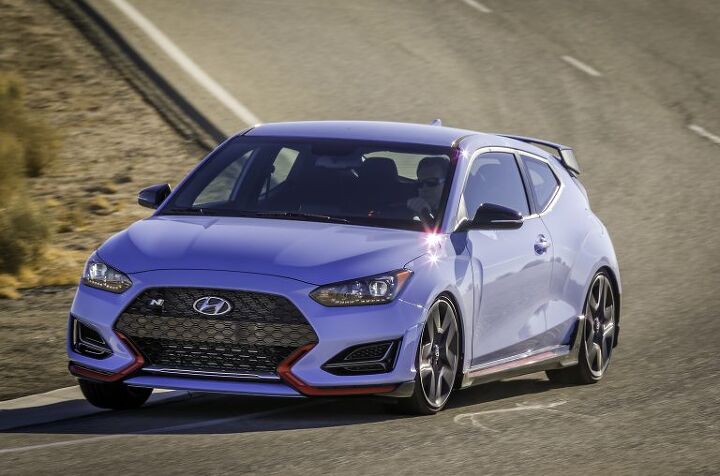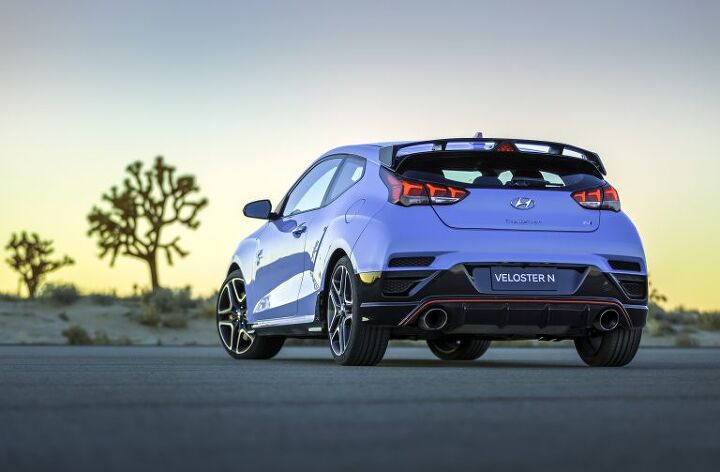New Details Spilled on Hyundai Veloster N; Additional Performance Variants to Wear N Badge

Hyundai’s Veloster has gone from an oddball offering drivers a reasonably good time on a budget to something that can compete with the Volkswagen GTI and Civic Si. It’s no longer the hot hatch you settled on to save money; it’s a legitimate alternative.
Outfitted properly, the updated Hyundai can hold its own in the hot hatch segment. However, it does not appear to shame any of the veteran entrants. The GTI remains the total package while other models offer their own unique advantages. But the Veloster, specifically the R-Spec with the 1.6-liter turbo, remains in the mix with a leaner price tag.
This changes when the Hyundai’s N sub-brand arrives in the U.S. market.
The Veloster N will have a 2.0-liter turbocharged engine with up to 275 horsepower and 260 foot-pounds of torque, according to Hyundai. This should place it in a sweet spot right above most sporty entry-level vehicles but just below something like the Focus RS, Golf R, or Civic Type R. Reviews of its sister car, the European-market i30 N, have shown it to be slightly lacking in refinement but abundant in character and fun.
On Friday, Hyundai introduced its high-performance N model for the U.S. market at Germany’s Nurburgring, showcasing the variant’s willingness to perform at “The Green Hell.”
The model has its own unique spoiler, rear diffuser, front fascia, grille, side sills, LED headlamps, LED tail lights, high-performance exhaust, larger brake rotors, and functional air ducts (YES!) that promote brake cooling. N-specific 18-inch wheels wrapped in standard 225/40R18 Michelin Pilot SuperSport summer tires also help it stand apart. However, you can order it with a set of 19-inch alloys with 235/35R19 Pirelli P-Zero rubber if you’d like.
For the interior, the Veloster N offers exclusive N-design front cloth sport seats with additional bolstering, as well as an N-design steering wheel, shift knob, and badging on the sill plates. There’s also some blue accenting here and there to reference the N-exclusive “Performance Blue” paint job. You can also have the car in white, black, or red for the 2019 model year.
The 2.0-liter, direct-injected turbocharged powerplant is larger and more powerful than the 201-horsepower Veloster Turbo by a fair margin. Hyundai estimates 275 horsepower at 6,000 rpm and up to 260 lb-ft of torque between 1,450 and 4,700 rpm. The two-stage turbo system’s intercooler has also been moved away from the condenser and radiator for more efficient cooling of the intake charge.
Hyundai claims the N’s six-speed manual transmission offers a close ratio, short throws, and downshift with rev-matching capability. It also goes to great lengths to explain how hard it worked on making sure the clutch was strong enough to take some real abuse and the ensuring the gearbox felt right.
In fact, there were many things said about how hard Hyundai worked to make sure the vehicle felt fun to drive (and to ensure it was up for a bit of thrashing). The only feature we have mixed opinions on is the electronic sound generator, which enhances the natural powertrain sound for the driver’s benefit. It already has a variable exhaust note that offers crackles and pops when you want it to; digital enhancements seem unnecessary. But we understand this is a pretty common practice in the industry right now.
If the Veloster N is anything like the i30 N, you’ll probably be able to shut that feature off thanks to an insane level of driver customizability.
There’s a trick multi-link suspension that manages load-transfer to keep the weight from shifting too far back on the front-drive hatchback during acceleration (and to prevent dive during braking), an electronically-controlled torque-vectoring system, and loads of customizable performance preferences via the Veloster’s “N Grin Control System.” Larger brakes mean 13.6-inch rotors in the front and 12.4-inch units in the rear. But 13.0 inchers in the front and 11.8 in the back are the standard setup.
Regardless of which options you splurge for, it all sounds incredibly good, and some of that goodness should extend to other models in the coming years.
While Hyundai hasn’t confirmed which souped-up vehicles will carry an N designation, it is building a trim level below that already. Called the “N-Line,” the units will boast unique styling, larger brakes, and should have access to a some mild performance upgrades. There is also the likelihood of N-Line aftermarket accessories for all Hyundai vehicles. From the sound of things, it will basically be the Hyundai equivalent of Mopar.
Unfortunately, there has been no confirmation on which cars will become fully fledged N models with beefed-up powertrains, but the rumor mill claims Hyundai already has something else in the works. The Veloster N will not stand alone forever.
[Images: Hyundai]

A staunch consumer advocate tracking industry trends and regulation. Before joining TTAC, Matt spent a decade working for marketing and research firms based in NYC. Clients included several of the world’s largest automakers, global tire brands, and aftermarket part suppliers. Dissatisfied with the corporate world and resentful of having to wear suits everyday, he pivoted to writing about cars. Since then, that man has become an ardent supporter of the right-to-repair movement, been interviewed on the auto industry by national radio broadcasts, driven more rental cars than anyone ever should, participated in amateur rallying events, and received the requisite minimum training as sanctioned by the SCCA. Handy with a wrench, Matt grew up surrounded by Detroit auto workers and managed to get a pizza delivery job before he was legally eligible. He later found himself driving box trucks through Manhattan, guaranteeing future sympathy for actual truckers. He continues to conduct research pertaining to the automotive sector as an independent contractor and has since moved back to his native Michigan, closer to where the cars are born. A contrarian, Matt claims to prefer understeer — stating that front and all-wheel drive vehicles cater best to his driving style.
More by Matt Posky
Latest Car Reviews
Read moreLatest Product Reviews
Read moreRecent Comments
- ToolGuy First picture: I realize that opinions vary on the height of modern trucks, but that entry door on the building is 80 inches tall and hits just below the headlights. Does anyone really believe this is reasonable?Second picture: I do not believe that is a good parking spot to be able to access the bed storage. More specifically, how do you plan to unload topsoil with the truck parked like that? Maybe you kids are taller than me.
- ToolGuy The other day I attempted to check the engine oil in one of my old embarrassing vehicles and I guess the red shop towel I used wasn't genuine Snap-on (lots of counterfeits floating around) plus my driveway isn't completely level and long story short, the engine seized 3 minutes later.No more used cars for me, and nothing but dealer service from here on in (the journalists were right).
- Doughboy Wow, Merc knocks it out of the park with their naming convention… again. /s
- Doughboy I’ve seen car bras before, but never car beards. ZZ Top would be proud.
- Bkojote Allright, actual person who knows trucks here, the article gets it a bit wrong.First off, the Maverick is not at all comparable to a Tacoma just because they're both Hybrids. Or lemme be blunt, the butch-est non-hybrid Maverick Tremor is suitable for 2/10 difficulty trails, a Trailhunter is for about 5/10 or maybe 6/10, just about the upper end of any stock vehicle you're buying from the factory. Aside from a Sasquatch Bronco or Rubicon Jeep Wrangler you're looking at something you're towing back if you want more capability (or perhaps something you /wish/ you were towing back.)Now, where the real world difference should play out is on the trail, where a lot of low speed crawling usually saps efficiency, especially when loaded to the gills. Real world MPG from a 4Runner is about 12-13mpg, So if this loaded-with-overlander-catalog Trailhunter is still pulling in the 20's - or even 18-19, that's a massive improvement.








































Comments
Join the conversation
I wondered since the first information came out about "N" coming to North America where is there any logic in picking the Veloster to start N with. I mean, there's an Elantra GT (a.k.a. i30N) racing in Pirelli World Challenge since March in North America (it won at Circuit of the Americas in Texas and last weekend in Portland Oregon). Also i30 N (Elantra GT) has been racing in Europe and available for the street in Europe. Meanwhile, the previous Veloster has been widely derided as having poor quality and visibility, and usually only desirable to very young people with smart phones crazy glued to their ears and they think as long as it has any engine in it..... In other words, wrong demographic. Potential hatchback GTi and Golf R types who care about car details would never buy a Veloster, but perhaps an Elantra GT.
The Elantra Sport is definitely on my radar... reviews have been excellent. Tho it's next to impossible to find one with the 6-speed manual in the L.A. area... and I don't think I'd consider the DCT. I'd consider ordering, if it came down to it... would make for a fun daily driver. The i30N would be overkill for me... I think I'd be happy with the Sport.